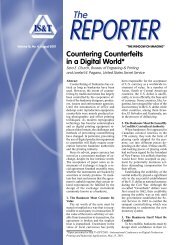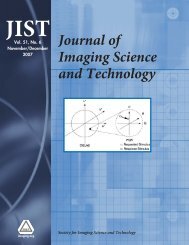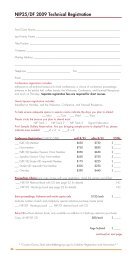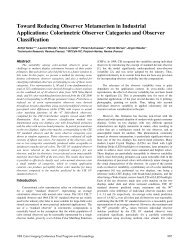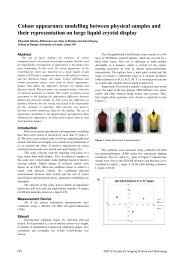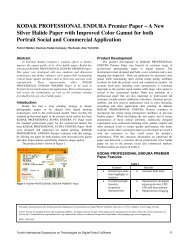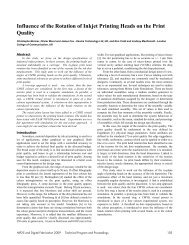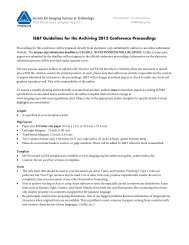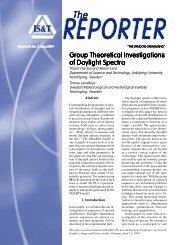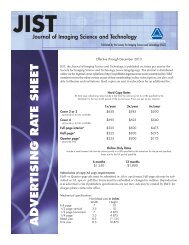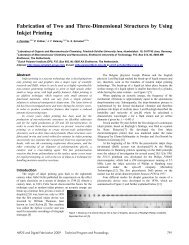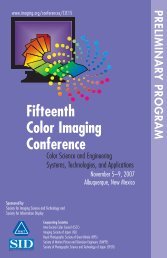Comparison of Colour Difference Methods for Natural Images
Comparison of Colour Difference Methods for Natural Images
Comparison of Colour Difference Methods for Natural Images
You also want an ePaper? Increase the reach of your titles
YUMPU automatically turns print PDFs into web optimized ePapers that Google loves.
<strong>Comparison</strong> <strong>of</strong> <strong>Colour</strong> <strong>Difference</strong> <strong>Methods</strong> <strong>for</strong> <strong>Natural</strong> <strong>Images</strong><br />
Henri Kivinen, Mikko Nuutinen, Pirkko Oittinen; Aalto University School <strong>of</strong> Science and Technology, Department <strong>of</strong> Media<br />
Technology; Espoo, Finland<br />
Abstract<br />
Perceptual colour difference in simple colour patches has<br />
been extensively studied in the history <strong>of</strong> colour science.<br />
However, these methods are not assumed to be applicable <strong>for</strong><br />
predicting the perceived colour difference in complex colour<br />
patches such as digital images <strong>of</strong> complex scene. In this work<br />
existing metrics that predict the perceived colour difference in<br />
digital images <strong>of</strong> complex scene are studied and compared.<br />
Per<strong>for</strong>mance evaluation was based on the correlations between<br />
values <strong>of</strong> the metrics and results <strong>of</strong> subjective tests that were<br />
done as a pair comparison, in which fifteen test participants<br />
evaluated the subjective colour differences in digital images.<br />
The test image set consisted <strong>of</strong> eight images each having<br />
four versions <strong>of</strong> distortion generated by applying different ICC<br />
pr<strong>of</strong>iles. According to results, none <strong>of</strong> the metrics were able to<br />
predict the perceived colour difference in every test image. The<br />
results <strong>of</strong> iCAM metric had the highest average correlation <strong>for</strong><br />
all images. However, the scatter <strong>of</strong> the judgements was very<br />
high <strong>for</strong> two <strong>of</strong> the images, and if these were excluded from the<br />
comparison the Hue-angle was the best per<strong>for</strong>ming metric. It<br />
was also noteworthy that the per<strong>for</strong>mance <strong>of</strong> the CIELAB<br />
colour difference metric was relatively high.<br />
Introduction<br />
The conventional CIE metrics (e.g. CIEDE2000 /1/))<br />
developed to estimate the colour differences <strong>of</strong> colour fields are<br />
capable to achieve a degree <strong>of</strong> prediction that is commonly<br />
acknowledged to be sufficient. These metrics require that the<br />
two stimuli being matched are presented using identical<br />
backgrounds and surroundings, and also that the two stimuli are<br />
viewed using identical illuminants and observers defined by the<br />
CIE. The results <strong>of</strong> the metrics are unreliable when these<br />
requirements are not met. Furthermore, these metrics are being<br />
used in quality control <strong>of</strong> colour reproduction, in which the<br />
recent cross media demands have made this conventional<br />
colorimetry insufficient.<br />
The CIECAM97 model and the updated CIECAM02<br />
model were developed to provide a viewing condition specific<br />
method <strong>for</strong> trans<strong>for</strong>ming tristimulus values into perceptual<br />
attribute correlates /2/. However, these models can only<br />
interpret simple colour patches due to their nonexistent<br />
capabilities to model the properties <strong>of</strong> spatial structure in<br />
complex images. These properties have received considerable<br />
attention in different fields <strong>of</strong> colour science, such as study <strong>of</strong><br />
image similarity and retrieval, image segmentation, image<br />
quality and human colour vision. The definition <strong>of</strong> complex<br />
images rises from their structure, which consists <strong>of</strong> different<br />
spatial frequencies. For example, photographs <strong>of</strong> a natural<br />
scene can be defined as a complex image.<br />
One <strong>of</strong> the earliest models that were developed to predict<br />
the degree <strong>of</strong> perceptual colour difference in images <strong>of</strong><br />
complex scenes is the S-CIELAB /3/. The extension to complex<br />
images was per<strong>for</strong>med by using a contrast sensitivity function<br />
(CSF). Hong and Luo /4/ developed a (Hue-angle) metric <strong>for</strong><br />
complex images that assigns higher weight to dominant colours<br />
and to colours having a greater difference. Chou and Liu /5/<br />
proposed a (P-CIELAB) metric <strong>for</strong> complex images that<br />
incorporates a visibility threshold <strong>for</strong> colour differences. This<br />
pixel-wise visibility threshold varies as function <strong>of</strong> chroma,<br />
local luminance gradient, and background uni<strong>for</strong>mity. Fairchild<br />
and Johnson /6/ have presented probably the most advanced<br />
model <strong>for</strong> colour appearance <strong>of</strong> complex images. Their iCAM<br />
framework includes different sub modules accounting <strong>for</strong><br />
various properties <strong>of</strong> images and viewing conditions in image<br />
analysis.<br />
The aim <strong>of</strong> this study was to test and compare the metrics<br />
or models <strong>for</strong> complex images in order to determine their<br />
capability to predict the degree <strong>of</strong> visually perceived colour<br />
differences in natural photographs. To the best <strong>of</strong> our<br />
knowledge, the study <strong>of</strong> Hardeberg et al. /7/ is the only<br />
published work where different state-<strong>of</strong>-the-art colour<br />
difference metrics <strong>of</strong> complex images have been compared to<br />
each other. They analysed the relation <strong>of</strong> CIELAB dE, S-<br />
CIELAB, iCAM, Structural Similarity Index /8/, Universal<br />
Image Quality /9/ and Hue-angle metric /4/ with data from a<br />
psychophysical experiment in which the perceptual image<br />
difference was evaluated. They used six test images, but only<br />
two <strong>of</strong> these images were natural photographs. The rest <strong>of</strong> the<br />
images were more or less studio photographs or graphical<br />
images. Their results indicated that perceptual image<br />
differences cannot be directly related to colour image<br />
differences as calculated using the current metrics.<br />
We evaluate the state-<strong>of</strong>-the-art metrics narrowing the<br />
problem from that defined by Hardeberg et al. /7/. A known<br />
fact is that image content exerts an influence on image<br />
assessment. For example, portrait and landscape are typical<br />
views in natural photography. We selected only landscape type<br />
images <strong>for</strong> our study, as they satisfied our needs <strong>for</strong> the<br />
requirement <strong>of</strong> colour distributions and spatial contents. We<br />
wanted that colour distribution <strong>of</strong> the images is wide enough<br />
because colour distortions were made using different ICC<br />
colour pr<strong>of</strong>iles. We also wanted that the spatial content <strong>of</strong> the<br />
images covers a wide range because we wanted to test how the<br />
methods take into account the spatial details <strong>of</strong> the image. In<br />
addition, our psychophysical experiment tested the perceptual<br />
colour difference, nor the perceptual image difference.<br />
Implementation <strong>of</strong> the metrics<br />
The metrics that were investigated and compared in this<br />
study are listed in Table 1. Selected metrics can be divided into<br />
different classes based on differences and similarities in their<br />
functional properties. The standardized metrics that are based<br />
on CIELAB dE colour difference were not originally developed<br />
to address differences in complex images, but they were<br />
selected to <strong>for</strong>m a baseline <strong>for</strong> the comparisons. These metrics<br />
include the CIELAB dE, CIE94 and CIEDE2000 metric /10/.<br />
510 ©2010 Society <strong>for</strong> Imaging Science and Technology
Table 1. The metrics that were used in the study<br />
Metric Intended use Reference<br />
dE <strong>Colour</strong> patches /10/<br />
CIE94 <strong>Colour</strong> patches /10/<br />
CIEDE2000 <strong>Colour</strong> patches /1/<br />
Hue-angle Complex images /4/<br />
P-CIELAB Complex images /5/<br />
S-CIELAB Complex images /3/<br />
iCAM Complex images /6/<br />
(a)<br />
(b)<br />
In addition, the implemented metrics includes also<br />
CIELAB based metrics that were developed to predict the<br />
appearance <strong>of</strong> complex images. These are the Hue-angle, P-<br />
CIELAB and S-CIELAB metrics. The first two are both similar<br />
in that they use a weighting scheme to address the structural<br />
properties <strong>of</strong> images, such that, a pixel-wise weight is applied<br />
to re-adjust a CIELAB dE value <strong>of</strong> the pixel to contribute to a<br />
more precise estimate <strong>of</strong> the perceived colour difference. But,<br />
as the Hue-angle metric computes the weight more globally, the<br />
P-CIELAB metric uses local properties <strong>of</strong> the image. The S-<br />
CIELAB, which is also called a spatial extension to CIELAB<br />
colour space, takes advantage <strong>of</strong> the filtering characteristics <strong>of</strong><br />
the human visual system (HVS) to apply the CIELAB dE<br />
metric to complex images. These characteristics are modelled<br />
with the contrast sensitivity function (CSF) in the frequency<br />
domain.<br />
Similarly, the iCAM framework uses the CSF, but instead<br />
<strong>of</strong> using the CIELAB colour space, it uses the IPT colour<br />
space. In addition, the iCAM framework consists <strong>of</strong> multiple<br />
modules that account <strong>for</strong> the viewing conditions and colour<br />
appearance phenomena. These include modelling <strong>of</strong> the<br />
chromatic adaptation, Hunt effect, Stevens effect, surround<br />
effect and lightness contrast effect.<br />
Test <strong>Images</strong><br />
The distorted test images were created by changing their<br />
colours through ICC pr<strong>of</strong>iles gamut mapping process. Here, the<br />
absolute colorimetric rendering intent was used with four<br />
standard ICC pr<strong>of</strong>iles: Euroscale Uncoated, ISO Uncoated,<br />
PSR Gravure LWC, and Uncoated FOGRA. The gamut <strong>of</strong><br />
these ICC pr<strong>of</strong>iles and the gamut <strong>of</strong> sRGB space in ab-plane<br />
are illustrated in Figure 1, where the visualizations have been<br />
obtained from ColorSync Utility included in Mac OS X. As can<br />
be seen from the figure, the ICC pr<strong>of</strong>iles can be divided into<br />
two groups based on their dimensions. This was done to ensure<br />
that there would be both larger and smaller differences between<br />
generated distortions.<br />
The selection <strong>of</strong> images <strong>for</strong> pilot tests from the candidate<br />
images was done by calculating average CIELAB dE values<br />
and then selecting those image sets that had average colour<br />
difference values on both sides <strong>of</strong> threshold value. The<br />
threshold value <strong>for</strong> colour difference discrimination in natural<br />
images is about 2.2 dE ab<br />
/11/. Finally, the selection was further<br />
narrowed to eight images. Seven <strong>of</strong> the images were from the<br />
Photos.com –database /12/ and one was from the CIE TC8-03<br />
test image set /13/. The test images are presented in Figure 2,<br />
where the images are named as Autumn road, Red field,<br />
Mountains, Forest rise, Red brushwood, Park, Table, and<br />
Picnic.<br />
(c)<br />
(d)<br />
(e)<br />
Figure 1. Gamut visualizations <strong>of</strong> the ICC pr<strong>of</strong>iles. (a) Euroscale<br />
Uncoated, (b) Uncoated FOGRA, (c) ISO Uncoated, (d) PSR Gravure<br />
LWC and (e) sRGB.<br />
Autumn road /12/ Red field /12/<br />
Mountains /12/ Forest rise /12/<br />
Red brushwood /12/ Park /12/<br />
Table /12/ Picnic /13/<br />
Figure 2. Selected test images<br />
CGIV 2010 Final Program and Proceedings 511
Test environment<br />
Subjective tests were conducted in a test room with matt<br />
grey painted walls and sealed windows. The viewing conditions<br />
in test room were adjusted to correspond to the sRGB reference<br />
viewing environment, which is presented in Table 1. According<br />
to these parameters the ambient illuminance level <strong>of</strong> the<br />
viewing conditions was set to approximately 200 lux with<br />
colour temperature <strong>of</strong> 5000 K. The illumination was done by<br />
using filtered halogen lamps. The illuminance level and the<br />
colour temperature were measured at the beginning <strong>of</strong> each test<br />
day.<br />
Table 2. sRGB reference viewing environment<br />
Condition<br />
sRGB<br />
Luminance level<br />
80 cd/m2<br />
Illuminant White<br />
x = 0.3127, y = 0.3291 (D65)<br />
Image surround<br />
20% reflectance<br />
Encoding Ambient<br />
Illuminance Level<br />
64 lux<br />
Encoding Ambient White<br />
Point<br />
x = 0.3457, y = 0.3585 (D50)<br />
Encoding Viewing Flare 1.0%<br />
Typical Ambient Illuminance<br />
Level<br />
200 lux<br />
Typical Ambient White Point x = 0.3457, y = 0.3585 (D50)<br />
Typical Viewing Flare 5.0%<br />
Fifteen test participants took part in the test. The age <strong>of</strong> the<br />
test participants were between 23 to 29 years, and four <strong>of</strong> them<br />
were female and eleven were men. All test participants had<br />
normal colour vision and all had normal or corrected visual<br />
acuity.<br />
The tests were conducted on a simple image pair<br />
comparison application, which was programmed with Java. The<br />
application includes display <strong>for</strong> inputting test participant<br />
in<strong>for</strong>mation, and two displays each presenting one image pair.<br />
The participant in<strong>for</strong>mation is collected at the beginning <strong>of</strong> the<br />
test, and after clicking the start button, the two image pair<br />
windows are maximized to fill one display. Be<strong>for</strong>e starting the<br />
test, the test participant reads the instructions, including the test<br />
question: which <strong>of</strong> the two pairs has a bigger difference<br />
compared to other image pair. After these preparations, the test<br />
participant is asked to start the test by clicking the background<br />
<strong>of</strong> one <strong>of</strong> the image pair windows. This is expressed by clicking<br />
the pair that has the larger perceived colour difference (see<br />
Figure 3).<br />
Display Two<br />
Figure 3. Example <strong>of</strong> the pair comparison application: image pairs, one on<br />
each display, are presented to test person, who has been instructed to<br />
select the pair that is perceived to have more colour difference.<br />
The image pairs were presented using Eizo ColorEdge<br />
CG241W displays. The displays were calibrated with Eizo<br />
ColorNavigator Calibration s<strong>of</strong>tware. The calibration was done<br />
by using a sRGB colour space emulation, which makes it<br />
possible to achieve as close to sRGB colour space full gamut as<br />
possible. The measurements <strong>for</strong> the calibration were done using<br />
X-Rite EyeOne Pro spectrophotometer. The colour<br />
reproduction per<strong>for</strong>mance was worst in bluish hue areas in both<br />
displays, while the average value <strong>of</strong> CIEDE2000 colour<br />
difference was between 0.4 and 0.6. The displays were also<br />
compared with each other to test their similarity, and even<br />
though the displays were the same model there were clear<br />
differences between them (Table 3).<br />
Table 3. <strong>Comparison</strong> <strong>of</strong> the two displays (CIEDE2000)<br />
Average 0.81<br />
Std. Deviation 0.72<br />
Best 90% 0.61<br />
Worst 10% 2.50<br />
Subjective data<br />
The subjective tests, as mentioned, were accomplished<br />
with psychophysical pair comparison tests. Although, the tests<br />
consist <strong>of</strong> comparison <strong>of</strong> two image pairs, the factor that is<br />
considered was the difference between two images <strong>for</strong>ming a<br />
pair. There<strong>for</strong>e, the law <strong>of</strong> comparative judgement by<br />
Torgerson /14/ was used in the analysis <strong>of</strong> the pair comparison<br />
data. The results <strong>of</strong> the subjective tests are presented in Table 4<br />
and Table 5. Each value in the tables represents the subjective<br />
difference scale value that was calculated from the comparison<br />
judgements. One test participant from total <strong>of</strong> sixteen<br />
participants, whose judgements differed clearly from other<br />
judgements, was excluded from the data.<br />
Display One<br />
512 ©2010 Society <strong>for</strong> Imaging Science and Technology
Table 4. Subjective difference scales <strong>for</strong> image contents<br />
Autumn road, Red fields, Mountains, and Forrest rise, and<br />
ICC pr<strong>of</strong>iles: (1) Euroscale Uncoated, (2) ISO Uncoated, (3)<br />
Uncoated FOGRA and (4) PSR Gravure LWC<br />
Mountains<br />
ICC pr<strong>of</strong>iles \<br />
images<br />
Autumn<br />
road<br />
Red<br />
Fields<br />
Forrest<br />
rise<br />
(1,2) - (1,3) * 0.201 0.280 0.183 0.580<br />
(1,2) - (1,4) 0.178 0.461 0.318 0.258<br />
(1,2) - (2,3) 0.175 1.223 0.283 0.372<br />
(1,2) - (2,4) 0.059 0.363 0.506 0.087<br />
(1,2) - (3,4) 0.065 0.624 0.383 0.174<br />
(1,3) - (1,4) 0.380 0.181 0.500 0.322<br />
(1,3) - (2,3) 0.377 0.943 0.465 0.208<br />
(1,3) - (2,4) 0.260 0.083 0.688 0.667<br />
(1,3) - (3,4) 0.267 0.344 0.566 0.406<br />
(1,4) - (2,3) 0.003 0.762 0.035 0.113<br />
(1,4) - (2,4) 0.119 0.098 0.188 0.346<br />
(1,4) - (3,4) 0.113 0.163 0.066 0.084<br />
(2,3) - (2,4) 0.117 0.860 0.223 0.459<br />
(2,3) - (3,4) 0.110 0.599 0.100 0.198<br />
(2,4) - (3,4) 0.007 0.261 0.123 0.261<br />
Average 0.162 0.483 0.308 0.302<br />
* Image pair (ICC1,ICC2) compared to Image pair (ICC1,<br />
ICC3)<br />
Table 5. Subjective difference scales <strong>for</strong> image contents Red<br />
brushwood, Park, Table, and Picnic, and ICC pr<strong>of</strong>iles: (1)<br />
Euroscale Uncoated, (2) ISO Uncoated, (3) Uncoated<br />
FOGRA and (4) PSR Gravure LWC<br />
Park Table Picnic<br />
ICC pr<strong>of</strong>iles \<br />
images<br />
Red<br />
brushwood<br />
(1,2) - (1,3) * 0.270 0.025 0.680 0.256<br />
(1,2) - (1,4) 0.954 0.444 1.231 0.114<br />
(1,2) - (2,3) 1.095 0.860 1.567 0.062<br />
(1,2) - (2,4) 0.085 0.932 1.478 0.089<br />
(1,2) - (3,4) 0.176 1.027 1.527 0.256<br />
(1,3) - (1,4) 0.684 0.420 0.551 0.142<br />
(1,3) - (2,3) 0.825 0.836 0.887 0.194<br />
(1,3) - (2,4) 0.355 0.908 0.799 0.345<br />
(1,3) - (3,4) 0.094 1.002 0.847 0.000<br />
(1,4) - (2,3) 0.141 0.416 0.336 0.052<br />
(1,4) - (2,4) 1.039 0.488 0.247 0.202<br />
(1,4) - (3,4) 0.778 0.583 0.296 0.142<br />
(2,3) - (2,4) 1.180 0.072 0.088 0.150<br />
(2,3) - (3,4) 0.919 0.167 0.040 0.194<br />
(2,4) - (3,4) 0.261 0.095 0.049 0.344<br />
Average 0.590 0.552 0.708 0.169<br />
* Image pair (ICC1,ICC2) compared to Image pair (ICC1,<br />
ICC3)<br />
The average subjective difference varies significantly between<br />
images. As a high subjective difference means that relatively<br />
many test participants chose that pair as one which has higher<br />
perceived difference, meaning that differences were more<br />
clearly perceived but also that the images have higher colour<br />
differences. The lowest average subjective scale value was <strong>for</strong><br />
images “Autumn road” and “Picnic”. The highest average<br />
subjective scale value was <strong>for</strong> image “Table”. The relationship<br />
between low subjective scale values and high deviation in<br />
judgement <strong>of</strong> the test participants is evident.<br />
Per<strong>for</strong>mance <strong>of</strong> the metrics<br />
The per<strong>for</strong>mance <strong>of</strong> the computational metrics was<br />
evaluated in relation to the differences <strong>of</strong> the resulting colour<br />
difference values between two images. Thus, a metric was<br />
capable <strong>of</strong> predicting perceptual colour difference in complex<br />
images if the difference between two calculated colour<br />
difference values correlated with the subjective difference<br />
(Table 6 and Table 7).<br />
As can be seen from the correlation values in Table 6 and<br />
Table 7, none <strong>of</strong> the metrics outper<strong>for</strong>m the others in the case<br />
<strong>of</strong> every image content. The Hue-angle metric had the best<br />
correlation <strong>for</strong> three <strong>of</strong> the images with significantly high<br />
per<strong>for</strong>mance, while the P-CIELAB metric had also the highest<br />
correlations in three <strong>of</strong> the image contents, two <strong>of</strong> them were<br />
with low statistical significance. The iCAM metric was the best<br />
per<strong>for</strong>ming metric only <strong>for</strong> two <strong>of</strong> the images, but the average<br />
correlation was the highest <strong>of</strong> the metrics indicating that the<br />
iCAM metric was the best per<strong>for</strong>ming metric. The second<br />
highest average correlation was <strong>for</strong> the Hue-angle metric.<br />
Table 6. Pearson linear correlation coefficients between the<br />
subjective colour differenece and predictions <strong>of</strong> CIELAB,<br />
CIE94, and CIEDE2000<br />
CIELAB CIE94 CIEDE2000<br />
Autumn road 0.113 -0.279 -0.142<br />
Red field 0.687 -0.070 0.163<br />
Mountains 0.797 0.210 0.647<br />
Forest rise -0.036 -0.061 0.109<br />
Red brushwood 0.361 -0.042 0.077<br />
Park 0.813 -0.045 0.324<br />
Table 0.905 0.688 0.908<br />
Picnic 0.011 -0.249 -0.209<br />
Average 0.457 0.019 0.235<br />
Table 7. Pearson linear correlation coefficients between the<br />
subjective colour differenece and predictions <strong>of</strong> Hue-Angle,<br />
P-CIELAB, S-CIELAB, and iCAM<br />
Hueangle<br />
P- S- iCAM<br />
CIELAB CIELAB<br />
Autumn road -0.047 0.857 0.273 0.827<br />
Red field 0.742 0.115 0.488 0.798<br />
Mountains 0.878 0.331 0.868 0.563<br />
Forest rise -0.046 0.323 0.195 0.070<br />
Red<br />
brushwood<br />
0.471 -0.301 0.110 0.659<br />
Park 0.832 -0.090 0.637 0.542<br />
Table 0.937 0.839 0.670 0.544<br />
Picnic 0.016 0.132 0.023 0.110<br />
Average 0.473 0.276 0.408 0.514<br />
As it was discussed earlier, the correlation <strong>of</strong> the metric<br />
varied according to different judgements. If we exclude the two<br />
image contents (Autumn Road, Picnic) that have high variation<br />
in the judgements, the average correlations are rather different.<br />
CGIV 2010 Final Program and Proceedings 513
Now, the iCAM metric has the average correlation <strong>of</strong> 0.529,<br />
meaning that the metric was only the third best per<strong>for</strong>ming<br />
metric, while even the CIELAB metric could outper<strong>for</strong>m it with<br />
average correlation <strong>of</strong> 0.588. While the best metric in terms <strong>of</strong><br />
average correlation is now the Hue-angle metric with average<br />
correlation <strong>of</strong> 0.636.<br />
The selection between using all eight images and six<br />
images is not straight<strong>for</strong>ward. It might seem proper to use all <strong>of</strong><br />
the images in metric per<strong>for</strong>mance evaluation; on the other hand,<br />
if test participants could not agree which image pair had greater<br />
difference in excluded images, then it might be proper to<br />
assume that the metrics would not need to predict the degree <strong>of</strong><br />
perceptual colour difference that does not exists.<br />
On the other hand, the metrics should be capable <strong>of</strong><br />
recognizing image content and related colour difference that is<br />
not perceivable by every observer or is such a colour difference<br />
that has subjective magnitude; <strong>for</strong> example, distorted image<br />
having colour difference in blue regions compared to an image<br />
having equal difference in red regions. Hence, it would be<br />
needed to study if there are such factors in the image content<br />
that may interfere observer’s conclusion <strong>of</strong> the colour<br />
difference.<br />
Nevertheless, relatively high per<strong>for</strong>mance <strong>of</strong> the CIELAB<br />
metric with both sets <strong>of</strong> six and eight images is remarkable.<br />
One reason <strong>for</strong> the success <strong>of</strong> the CIELAB metric might be in<br />
the global <strong>for</strong>mation <strong>of</strong> the colour difference. In such cases, the<br />
effect <strong>of</strong> structural properties <strong>of</strong> the image content is minor. For<br />
example, test images “Park” and “Table” have uni<strong>for</strong>mly<br />
located colour differences that were well predicted by the<br />
metric, while the effect <strong>of</strong> image structure in test images<br />
“Autumn road” and “Red brushwood” may have a greater<br />
effect on the perceived <strong>of</strong> colour difference which was not<br />
predicted by the CIELAB.<br />
The correlations between metrics evaluated from all<br />
values, are shown in Table 8. As can be seen, the Hue-angle<br />
and CIELAB metrics are significantly correlated with each<br />
other. This is rather remarkable when considering how complex<br />
the process <strong>of</strong> the Hue-angle metric is, although it is built on<br />
CIELAB. This indicates that the effect <strong>of</strong> image content is<br />
rather small in the Hue-angle model. The values <strong>of</strong> CIE94 were<br />
closest to CIEDE2000, while it did not have any correlation<br />
with iCAM metric, and only minor correlation with other<br />
metrics. The CIEDE2000 metric had only minor correlation<br />
with other metrics except CIELAB and CIE94.<br />
Table 8. Correlations between metrics. (1) CIELAB, (2)<br />
CIE94, (3) CIEDE2000, (4) P-CIELAB, (5) Hue-Angle, (6)<br />
iCAM.<br />
2 3 4 5 6 7<br />
1 0,387 0,706 0,004 0,914 0,648 0,786<br />
2 - 0,843 0,330 0,262 0,045 0,272<br />
3 - - 0,301 0,527 0,296 0,536<br />
4 - - - -0,070 -0,103 0,005<br />
5 - - - - 0,603 0,718<br />
6 - - - - - 0,665<br />
Conclusions<br />
Overall, the state <strong>of</strong> the art metrics that were tested in this<br />
study are not completely capable to predict the degree <strong>of</strong><br />
perceived colour difference in images <strong>of</strong> complex scenes. Two<br />
metrics came up in the comparison: iCAM and Hue-angle. If all<br />
the images are considered, the iCAM is the best per<strong>for</strong>ming<br />
metric. While the Hue-angle metric is the best per<strong>for</strong>ming<br />
methods if we excluded those image contents that could not be<br />
judged without a high variation in judgements. In this case the<br />
iCAM-metric is only the third best method after CIELABmetric.<br />
Additionally, the iCAM-metric has its strengths in image<br />
appearance modelling, while the Hue-angle metric has its<br />
advantages in modelling the effect <strong>of</strong> image structure. The<br />
future metric should be a hybrid model that has both image<br />
appearance and image structure modelling capabilities. One<br />
example <strong>of</strong> a hybrid model could be a metric that uses<br />
segmentation <strong>of</strong> colour difference map to find spatial areas that<br />
have higher impact on perceived colour difference.<br />
References<br />
[1] Luo. M. R., Cui. G., Rigg. B. The Development <strong>of</strong> the CIE<br />
2000 <strong>Colour</strong>- <strong>Difference</strong> Formula: CIEDE2000. Color Research &<br />
Application. vol. 26. Nro. 5, 340-350 (2001).<br />
[2] Moroney. N., Fairchild. M. D., Hunt. R. W. G., Li. C., Luo.<br />
M. R., Newman T. The CIECAM02 color appearance model.<br />
IS&T/SID 10th Color Imaging Conference, 23-27 (2002).<br />
[3] Zhang. X., Wandell. B. A. A Spatial Extension <strong>of</strong> CIELAB <strong>for</strong><br />
Digital Color Image Reproduction. Proceedings <strong>of</strong> the SID<br />
Symposiums. 731-734 (1997).<br />
[4] Hong. G., Luo. R. Perceptually based colour difference <strong>for</strong><br />
complex images. Proc. SPIE, vol. 4421, 618-621 (2002).<br />
[5] Chou. C-H., Liu. K-C. A Fidelity Metric <strong>for</strong> Assessing Visual<br />
Quality <strong>of</strong> Color <strong>Images</strong>. Proc. 16th International Conference on<br />
Computer Communications and Networks. ICCCN 2007, 1154-<br />
1159 (2007).<br />
[6] Fairchild. M. D., Johnson. G. M. Meet iCAM: A Next-<br />
Generation Color Appearance Model. Proc. IS&T/SID 10th Color<br />
Imaging Conference: Color Science. Systems and Applications, 33-<br />
38 (2002).<br />
[7] Haderberg, J. Y., Bando, E. & Pedersen, M. (2008) Evaluating<br />
colour image difference metrics <strong>for</strong> gamut-mapped images.<br />
Coloration Technology, vol. 124, Nro 4, 243-253 (2008).<br />
[8] Wang. Z., Bovik. A. C., Sheikh. H. R., Simoncelli. E. P. Image<br />
Quality Assessment: From Error Measurement to Structural<br />
Similarity. IEEE Transactions on Image Processing, vol. 13, Nro 4,<br />
600-612 (2004).<br />
[9] Wang, Z., Bovik, A. C., A universal image quality index,<br />
Signal Processing Letter, Vol. 9, Nro 3, 81-84 (2002).<br />
[10] Witt. K. CIE Color <strong>Difference</strong> Metrics. In: Schanda. J.<br />
(Edited): Colorimetry: Understanding the CIE System. John Wiley<br />
& Sons. Inc.. Hoboken. New Jersey. 79-100 (2007).<br />
[11] Aldaba, M. A., Linhares, J. M. M., Pinto, P. D., Nascimento,<br />
S. M. C., Amano, K., Foster, D. H. Visual sensitivity to color errors<br />
in images <strong>of</strong> natural scenes. Visual Neuroscience, vol. 23. 555-559<br />
(2006).<br />
[12] Anon. (n.d) Photos.com (online). Juppiterimages. Updated<br />
13.03.2009 [referred 13.03.2009]. Available in WWW: <br />
[13] CIE (2004). CIE Division 8 – TC8-03: Gamut Mapping.<br />
Guidelines <strong>for</strong> the Evaluation <strong>of</strong> Gamut Mapping Algorithms<br />
514 ©2010 Society <strong>for</strong> Imaging Science and Technology
(online). Updated 02.09.2004 [referred 13.03.2009]. Available in<br />
WWW: <br />
[14] Torgerson. W. S. Multidimensional Scaling: I. Theory and<br />
Method. Pyschometrika. vol 17, Nro 4, 401-419 (1952).<br />
Author Biography<br />
Henri Kivinen received his Master’s degree in Graphic arts<br />
technology from the Aalto University, Finland (2010). This work is his<br />
Master project results at the university. Since then his work at the Aalto<br />
University has included media related research on a broader scope.<br />
CGIV 2010 Final Program and Proceedings 515




